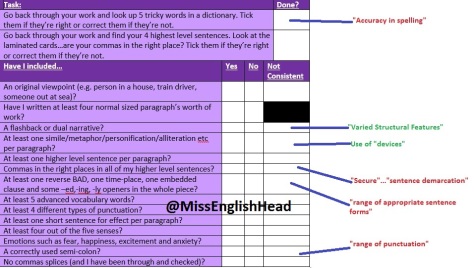As always, this blog is designed to share some techniques I use with my students who are tackling the 2017 AQA Lit/Lang exams. I do not claim to know it all and -in fact- welcome feedback and corrections wherever possible. We are all bumbling through the curriculum changes so let’s bumble through together!
This blog will focus on how we can ensure that students hit all AOs in the Lit/Lang analysis questions, in the dreaded 100% exams, without us there to remind them to include quotes and so on. There is a lot of negativity online about how PEAL/PEE/PETER/PETAL/TEPAE and so on are all well and good at KS3 but are useless at KS4. I both agree and disagree with the statement. I agree that they can be restrictive for some students and, in these basic states, are not designed to hit the high marks. However, I believe that the only way we are going to train students to not forget to jump through the relevant hoops in their exams is to drill them in some form of structure. My preferred one is PETAL… but with a VERY BIG twist.
PETAL
PETAL stands for:
- Point: I believe that…
- Evidence: This is shown by the quote…
- Technique: This is an example of _____ or This has connotations of…
- Analysis (Explain): This quote proves my point because…
- Link back to Q: Therefore, I believe that…
If you are trying to get a bottom set class to put in some form of structure to their responses and not just re-tell the narrative, PETAL will do you fine. However, it will not help anyone who is looking at a half decent grade.
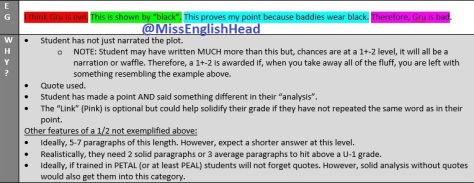
So what do we do?
Introducing PETAETAETAAAAL:
Bare with me… it sounds a lot more confusing than it is!
In my classes, students are taught PETAL and then rapidly move to PETAAAL and then PETAETAAAL and eventually make their way up to PETAETAETAAAAL (pronounced: Peter-eater-eater-ahhhhhhl <– add some speed and the acknowledgement that you sound like a muppet and the students laugh!).
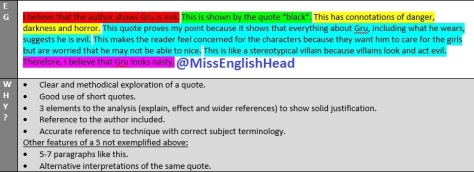
^PETAAAL
Let’s break it down:
- Point: I believe that…
- Evidence: This is shown by the quote…
- Technique: This is an example of… or This has connotations of…
- Analysis (Explain): This quote proves my point because…
- Evidence 2: This is also shown by the quote…
- Technique: Which is an example of…
- Analysis (Explain): and proves my point because…
- Evidence 3: Repeat
- Technique: Repeat
- Analysis: Repeat
- Analysis (Effect): These quotes could make the reader feel _____ because…
- Analysis (Effect 2): Also, these quotes could make the reader feel ____ because..
- Analysis (Context): These quotes link to ___(e.g. life in Dickensian times)___ because…
- Link back to Q: Therefore, I believe that…
By the time they are working at this level, they are trained in the types of ways you can finish off each of the sentence starter and end up creating a really detailed, analytical paragraph.
But surely that is not enough for the highest marks?!
True. For the highest marks, you need evaluation, embedded quotes and for it to sound less robotic.
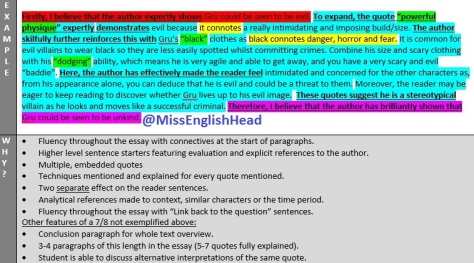
^PETAETAETAAAAL
Let me explain how I do this:
- Students have been scaffolded as they work their way from PETAL to PETAETA(etc) where they are using multiple quotes to build an overarching, perceptive (<–Ooo mark scheme buzz word there!) argument. They will naturally start to combine sentences, build paragraphs in a different order and so on. I welcome this.
- We do a lot of joint construction where a student types at my laptop as it is live projected on the board and peers tell them what to write. Here, I help them write the first half of a paragraph and then go back through and take out the waffle, for example. This shows them, live, how to turn the scaffolds they are used to into embedded quotes.
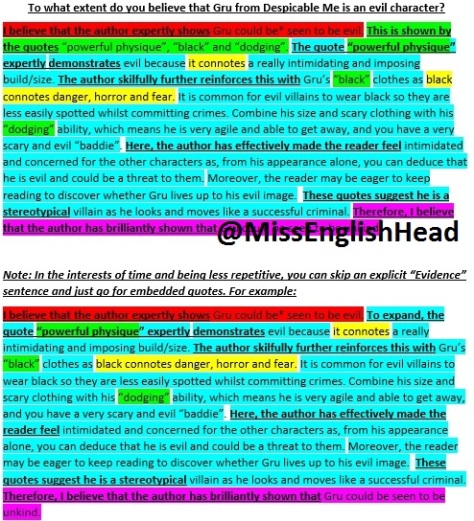
- For the evaluation, I have PETAL paragraph builder cue cards with a list of sentence starters of varying levels on them and the students can pick and choose. They are now trained to pick the ones with words like “effectively” in.

With students who are fully trained in PETAETA(etc), this is all the support I give them. In a lesson, I will -at short notice- tell them to write an exam style response to X question and just give them this to help. They find that this is all they need.
How will this help them in the exam though, when there aren’t scaffolds?
The idea is that, by the exam, the students will have memorised the higher level sentence starters and what PETAETAETAAAAL stands for so they will be scaffolding themselves in their minds. Due to their training on each letter of PETAETA(etc) they are less likely to fall into the trap of forgetting to comment on the effect on the reader and so on as they will remember me sounding like a muppet as I say PETAETAETAAAAL every 5mins!
The example responses from AQA feature multiple, embedded quotes which is something that standard PETAL does not encourage. Therefore, PETAETA(etc) is the way to get them used to creating anything that reflects what the boards are asking for.
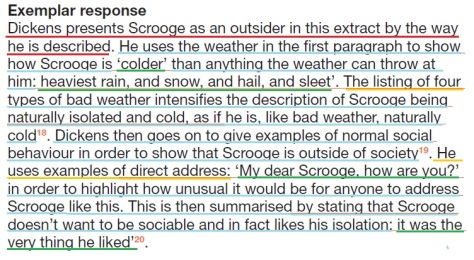
^(Credit to AQA – Colours = me) I have tried to keep it with the same colour coding. You can see 3 quotes (green), 2 techniques (yellow), a clear point (red) and plenty of analysis (blue).

^AQA 2017 Spec Lit Mark Scheme (Colours = me)
You said it applied to the 2017 AQA Eng Lang exams. How?
You will have noticed that the new spec Eng Lang asks students to analyse the use of language, structure and form in given texts. Whilst many of these questions are 8(ish) marks and, therefore, do not require every letter of PETAETAETAAAAL, a variation of PETAL is needed as students throw away marks if they forget quotes.. and so on.

^AQA 2017 Lang Paper 1, section A example student response. Colour = me.
How on earth are students expected to remember PETAETAETAAAAL?! It’s so long!
I agree. It’s a faff. However, in a way, it is not designed to be a rigid frame to confuse students who do the letters in the wrong order and so on. It is simply designed to remind students to go beyond PEAL/PETAL. When a student is trained in it, they only need to remember PETAAAAL and just remember to repeat the quote-technique-analysis bit 3 times…much more easily digested!
Our revision sessions can focus on making sure students remember “Analysis-Explain”, “Analysis-Effect” and “Analysis-Context” which is a lot easier than trying to teach them to include context in the abstract.
So there we have it…
PETAETAETAAAAL and all of if it’s differentiated variants. A good way to train students to analyse and evaluate 2017 AQA Lit & Lang sources.
All references to PETAETA and the examples about Gru from Despicable Me are my own creation. Obviously, credit to the makers of Despicable Me for creating the film I could base my examples on and credit to AQA for the exemplar paragraphs.












 One could very easily just display this and explain what it means to students. However, we all know that teenage minds are 20% fluff, 40% daydream about their one true love, 30% hunger, 5% things they shouldn’t be thinking about and only 5% work… if that. Therefore, do we really expect them to not just smile and nod as we dissect these rather abstract AOs for them?
One could very easily just display this and explain what it means to students. However, we all know that teenage minds are 20% fluff, 40% daydream about their one true love, 30% hunger, 5% things they shouldn’t be thinking about and only 5% work… if that. Therefore, do we really expect them to not just smile and nod as we dissect these rather abstract AOs for them?

